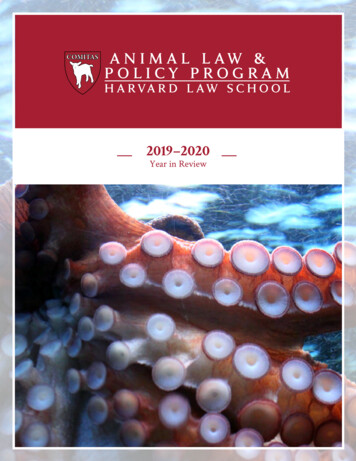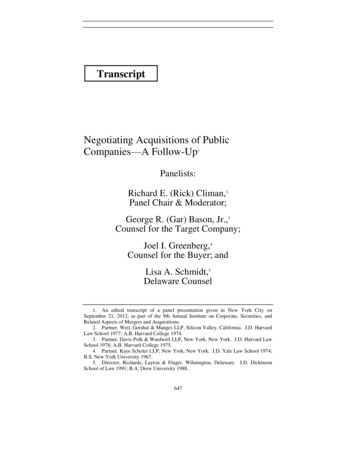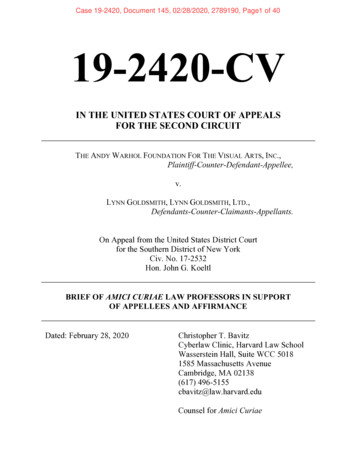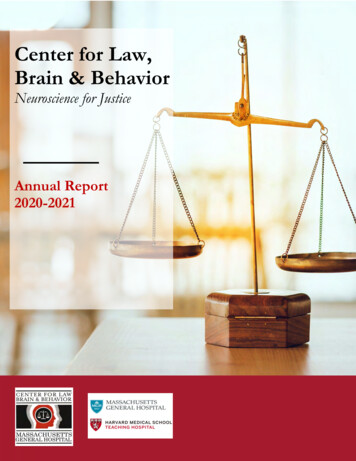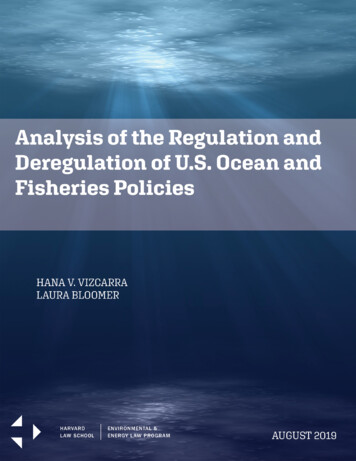
Transcription
About the AuthorsHana V. Vizcarra is Staff Attorney at Harvard Law School’s Environmental & Energy Law Program (EELP) whereshe leads EELP’s portfolio on private sector approaches to climate and environmental issues and conducts legalanalysis on regulatory development in environmental and energy law. Before joining EELP in 2018, Hana practicedenvironmental law in Washington D.C. for two national law firms. In private practice she represented clientsin complex environmental litigation, counseled on environmental compliance and regulation, and advised onenvironmental aspects of transactions. Before becoming an attorney, Hana spent seven years working in politicalresearch and communications. Hana received her J.D. from Georgetown University Law Center and B.A. fromPomona College in California.Laura Bloomer is an EELP Legal Fellow beginning in Fall 2019. She is a 2019 graduate of Harvard Law School andHarvard Kennedy School, earning a J.D., cum laude, and a Masters in Public Policy. Prior to law school, Laura workedon President Obama’s reelection campaign and taught English in East Java, Indonesia with the Peace Corps. Laurareceived her B.A. from the University of Texas at Austin.AcknowledgmentsThis publication was produced with the financial support of the European Union. Its contents are the soleresponsibility of authors Hana Vizcarra and Laura Bloomer and do not necessarily reflect the views of the EuropeanUnion.The Harvard Law School Environmental & Energy Law Program influences policy discussions about environmental,climate, and energy issues. We apply rigorous legal analysis to identify shortcomings and opportunities for change inorder to achieve improved environmental outcomes.Harvard Law School, Environmental & Energy Law Program6 Everett Street, Suite 4119Cambridge, MA 02138eelp.law.harvard.edu 2019 by the Harvard Law School Environmental & Energy Law Program. All rights reserved.
Executive Summarybuilt into the ocean and coastal statutes. The currentadministration has shown a willingness to continueimplementation of certain fisheries managementreforms initiated in the prior administration, perhapsindicating certain policy areas may not experienceextensive priority shifts.Executive SummaryWhile changes in political leadership affect U.S.ocean and coastal management strategies,the trajectory of U.S. policy over time has beento advance comprehensive consideration ofthe interconnected ecological ocean system ininternational and domestic ocean management.Domestically, regional planning and protectiveapproaches have helped regulators balance multiple,often conflicting uses that can affect ecosystemresilience.However, U.S. wariness of multi-lateral internationalagreements challenges environmentally consciousocean management goals. Recent domestic oceanpolicies emphasize fossil energy development overconservation and sustainability concerns. Proposalsregarding offshore resource development as well asderegulatory efforts could impact ocean resourcesand have repercussions in international fora.At the domestic level, limits on the currentadministration’s ability to abruptly finalize majorchanges to ocean and coastal management exist:jurisdictional authorities are split among federal andstate powers and among multiple agencies, andscience-based and procedural requirements areThis paper reviews the legal and regulatoryframework supporting U.S. coastal and oceanmanagement, and describes changes under thecurrent administration.a Comprehensive reviewsof the legal framework and regulations of topicscovered in this report already exist,1 but there isvalue in considering the overarching legal frameworkand understanding how these separate technicalareas interrelate. This paper focuses on policytopics prioritized under the current and most recentadministrations and assesses the state of play of theongoing deregulation process.Overall, ocean management has seen less dramaticchange than other areas of environmental regulationduring this administration, such as air, water, climate,and energy. Most action on ocean issues has, thusfar, concentrated on domestic policy. However, thethemes exhibited at the domestic level are beginningto reflect on the international stage and to shift thedialogue with the EU and other partners.The administration’s unwillingness to continueprevious domestic policies on climate change anda In addition to the information in the body of this paper, an attachedAnnex provides detail on relevant statutes, executive orders, and a smallnumber of international agreements to provide context for the topicsdiscussed. This paper builds on EELP’s expertise in U.S. environmentaland energy law and its efforts to track regulatory developments underthe current administration in its Regulatory Rollback Tracker.Analysis of the regulation and deregulation of U.S. ocean and fisheries policies Hana V. Vizcarra and Laura Bloomer1
Chapter name hereopposition to international agreements involvingcommitments to do so (for example, in announcingthe U.S. intends to withdraw from the Paris ClimateAgreement) have a direct impact on Arctic policiesand may also impact ocean and coastal issuesclosely tied to climate, such as acidification, sealevel rise, and adaptation. Yet, at the national level,this administration has supported narrow efforts toaddress marine debris and plastics in the oceans.Policies and actions in areas crucial to themanagement of ocean and coastal areas reveal apattern of prioritizing economic interests and energydevelopment over conservation and protection. Onissues not directly tied to climate and not thoughtto hinder U.S. energy industry development, thisadministration has exhibited a degree of continuityin position with the prior administration—such as onillegal, unreported, and unregulated (IUU) fishing andsigning of an agreement preemptively barring fishingin the Central Arctic Ocean. Continued developmentof offshore wind energy could also be an avenuefor increased cooperation with the EU as much ofthe existing expertise in this area lies with EU-basedcompanies. Recent estimates suggest there are22,000 MW of offshore wind potential off the eastcoast of the U.S.—representing a possible 70 billionof economic opportunity.Analysis of the regulation and deregulation of U.S. ocean and fisheries policies Hana V. Vizcarra and Laura Bloomer2
Table of ContentsExecutive Summary 11. U.S. Legal Framework for Ocean and Coastal Governance 4A. The U.S. and International Law of the Sea (UNCLOS) 4B. Domestic Statutory Structure and Jurisdictional Divisions 5Framework/Management Statutes 5Conservation Area Statutes 6Environmental Statutes 5C. The Development of a National Ocean Policy 7D. Implementing Agencies 82. The Trump Administration Approach to Deregulation and Ocean Governance 10A. Executive Order 13840 on Ocean Policy 11B. Offshore Energy Development 12C. Habitat and Natural Resource Conservation 14D. Domestic Fisheries Management 15E. International Fisheries Management and Ocean Conservation 173. Stakeholder Views and Responses 19A. States, Local Governments, and Tribes 19B. Congress 20C. Industry 21D. Non-profits and Think Tanks 22Conclusion 23Endnotes 24Annex 33Analysis of the regulation and deregulation of U.S. ocean and fisheries policies Hana V. Vizcarra and Laura Bloomer3
U.S. Legal Framework for Ocean & Coastal GovernanceI. U.S. Legal Frameworkfor Ocean and CoastalGovernanceA web of statutes, executive actions, and regulationsimplemented by federal, regional, and state entitiesgoverns U.S. ocean management. Federal statutescreate the framework for U.S. ocean governance, andmultiple federal agencies (and offices within them)implement these statutes. States hold significantocean and coastal management responsibilitiesas well, largely controlling resources within threenautical miles of the coast and sharing enforcementand implementation responsibilities with the federalgovernment under various environmental statutes.Domestic law also intersects with international law,as we discuss in more detail below.U.S. resource and conservation law began evolvinginto contemporary environmental law in the early1970s, following a series of highly publicizedgaps in environmental protection.2 This transitionlargely set in place the current U.S. legal structureon environmental and resource issues which isdiscussed in more detail in section I.B. below.There are two statutes not exclusive to ocean andcoastal law that play an important role in federalregulatory development. The AdministrativeProcedure Act (APA) prescribes how federal agenciespromulgate, revise, or rescind regulations. Itestablishes the parameters for public comment,how an agency considers these comments, and towhat extent the agency must explain its decisions.The National Environmental Policy Act (NEPA) isa foundational statute of U.S. environmental law.Signed in 1970, NEPA requires agencies to conductenvironmental reviews prior to commencing majorfederal actions that could significantly affectthe environment. While it does not compel thegovernment to choose the most environmentallyprotective option, it requires the agency to take a“hard look” at the effects of government action andto consider alternatives.A. The U.S. and InternationalLaw of the Sea (UNCLOS)Despite its decision not to ratify the United NationsConvention on the Law of the Sea (UNCLOS), the U.S.has consistently maintained that UNCLOS reflectscustomary international law,3 and the actions ofnumerous administrations have demonstratedthis. Former President Reagan claimed the U.S.’sExclusive Economic Zone (EEZ) in accordance withthe provisions of UNCLOS a year after it was signed,4the Department of Defense operates a Freedom ofNavigation Program in which it challenges “excessivemaritime claims” “inconsistent with internationallaw as reflected in the Law of the Sea Convention,”5and the Department of State reviews U.S. actions toensure they accord with the convention.6The U.S. actively participated in the negotiation ofUNCLOS, but President Reagan ultimately pulledback support, withholding signature due to concernsover the deep seabed mining provision.7 Continuednegotiations led to a 1994 agreement addressingthese concerns,8 following the 1994 adjustments,UNCLOS went into force. President Clinton signed theconvention and sent it for the advice and consentof the Senate, which is required for ratification,9 butAnalysis of the regulation and deregulation of U.S. ocean and fisheries policies Hana V. Vizcarra and Laura Bloomer4
U.S. Legal Framework for Ocean & Coastal Governancethe Senate failed to grant it.10 Newt Gingrich’s 1994“Republican Revolution” and “Contract with America”ushered in an aggressively partisan approach topolitics, changing the political dynamics for years tocome and spilling into the debate of UNCLOS in thethen-Democratically led Senate.11 Both PresidentsBush and Obama have since led failed efforts toobtain the advice and consent of the Senate so thatthe U.S. could become a party to the convention.12The current administration has not undertaken anysimilar effort to gain consent.13U.S. ocean management, particularly related tofisheries management and commercial activities, isintertwined with international law. The U.S. remainsan active participant in multi-lateral negotiationsaffecting oceans, marine activity, and speciesprotection. For example, the U.S. is a party to the1995 United Nations Fish Stocks Agreement,which implements provisions of UNCLOS regardingstraddling stocks and highly migratory fish.14 Asa party to the Port State Measures Agreement,the U.S. passed the 2015 Illegal, Unreported,and Unregulated (IUU) Fishing Enforcement Act toimplement the agreement. The act imposes civil andcriminal sanctions on violators of the enforcementprovisions and requires the Secretary of Commerceto report and take action against countries that donot address illegal fishing. It also authorizes theSecretary to prevent ships carrying IUU-obtainedfish from entering port. NOAA Fisheries participatesin international trade organizations and tracksagreements concerning living marine resources.15B. Domestic Statutory Structureand Jurisdictional DivisionsU.S. law relevant to ocean policy includes a complexstatutory structure that defines the responsibilitiesof various levels of government; attempts to balancethe protection of land/offshore areas, habitats,plants, and animals with the productive use ofeconomically important resources; outlines agencydecision-making requirements (i.e., NEPA and theAPA discussed above); sets standards and createspermitting schemes to protect human health and theenvironment.This section discusses some of the most importantstatutes governing ocean protection and themanagement of ocean resources. For a discussionof current legislative proposals on ocean issues,see Section 3.B. discussing Congress. Additionalexplanations of the statutes discussed in this sectionas well as others can be found in the attachedAnnex.FRAMEWORK / MANAGEMENT STATUTESThe four primary statutes governing the managementof coastal and offshore resources and defining theresponsibilities of different government jurisdictionsinclude: the Submerged Lands Act, the OuterContinental Shelf Lands Act (OCSLA), the CoastalZone Management Act (CZMA), and the MagnusonStevens Fishery Conservation & Management Act(Magnuson-Stevens Act or MSA).The Submerged Lands Act (1953) gave states titleto submerged lands and the natural resources inthe lands and waters up to three nautical milesfrom the coastline. Texas and Florida argued forAnalysis of the regulation and deregulation of U.S. ocean and fisheries policies Hana V. Vizcarra and Laura Bloomer5
U.S. Legal Framework for Ocean & Coastal Governanceand received a more expansive jurisdiction of threeleagues (nine nautical miles) from the coastline dueto historical factors.16 The Submerged Lands Actwas Congress’s response to a series of SupremeCourt cases severely limiting states’ jurisdiction.17The Outer Continental Shelf Lands Act (OCSLA) (also1953) gave the federal government jurisdiction overall submerged lands and their resources seawardof the state-managed areas to the edge of theU.S.’s continental shelf. OCSLA establishes themanagement structure for the leasing, development,and regulation of offshore energy and mineralresources. The Coastal Zone Management Act(CZMA), passed in 1972, authorized state and localgovernments to develop and implement coastalmanagement plans with federal support and set upprocedures for encouraging consistency betweenstate plans and federal actions.The 1976 Magnuson-Stevens Act defined thefederal and state jurisdictional split over fisheryresources. It established federal authority from theedges of state waters out to 200 miles, what isnow called the EEZ under UNCLOS and customaryinternational law.18 While states have primary controlover fisheries within their waters, the act providesfor federal control over activities in state watersimpacting fisheries predominantly in federal waters.It also provides for some state regulation in federalwaters involving fisheries without federally approvedfishery management plans. As the frameworkstatute for fisheries management, MSA governs theconservation and management of living U.S. oceanresources.Together these statutes authorize states to retaingeneral jurisdiction of coastal zones, submergedlands, and coastal waters extending three nauticalmiles from the shore, while the federal governmentexercises near-exclusive jurisdiction over the watersand submerged lands between three and 200nautical miles from shore, with some obligations toconsult and consider state priorities and concerns.CONSERVATION AREA STATUTESTwo additional statutes allow for the developmentof marine conservation areas. In 1972, theNational Marine Sanctuaries Act created a processfor Congress and the National Oceanic andAtmospheric Administration (NOAA) (a sub-agencyof the Department of Commerce) to designateprotected marine sanctuaries. Similarly, presidentshave invoked the much older 1906 AntiquitiesAct to designate marine areas of historic, cultural,or scientific importance as national monuments,protecting them from commercial activities.ENVIRONMENTAL STATUTESEnvironmental statutes applicable to both onshoreand offshore activities establish procedural andpermitting requirements and impose controls onactivities, including those that impact the oceans.For example, the Clean Water Act, Marine MammalProtection Act, Endangered Species Act, MigratoryBird Treaty Act, National Environmental Policy Act(NEPA), and Oil Pollution Act all apply to coastal andocean activities.The Clean Water Act regulates discharges ofpollutants into the marine environment and requirespermits for pollutant discharge into state or federalwaters.19 It includes both technology- and waterquality-based limitations enforced nationally throughAnalysis of the regulation and deregulation of U.S. ocean and fisheries policies Hana V. Vizcarra and Laura Bloomer6
U.S. Legal Framework for Ocean & Coastal Governancepermitting regimes and water quality standards.States set water quality standards for coastal andstate waters. The Clean Water Act also regulatescertain discharges from vessels as well as thedredge and fill of coastal wetlands. The Riversand Harbors Act likewise requires permits forconstruction, excavation, and depositing materials injurisdictional waters.The Marine Mammal Protection Act prohibitsunauthorized injuring or killing of marine mammals.The Migratory Bird Treaty Act similarly protects listedmigratory birds from unauthorized takings, andincludes many seagoing species. Species that areendangered or threatened, as well as habitat criticalfor their recovery, are further protected from harmfulhuman activity by the Endangered Species Act. TheOil Pollution Act, passed in 1990, a year after theExxon Valdez oil spill in Alaska, amended the CleanWater Act to establish a strict liability regime for oilspills and outline spill response authorities, as wellas require spill response planning from vessels andthe government.There are numerous additional statutes addressingspecific ocean-related topics and research priorities.Examples are the Marine Debris Research,Prevention, and Reduction Act (2006); the FederalOcean Acidification Research and Monitoring Act;the Marine Protection, Research, and SanctuariesAct (the Ocean Dumping Act); the Arctic Researchand Policy Act; and the Illegal, Unreported, andUnregulated Fishing Enforcement Act of 2015. Manyof these laws fit within the legal structure describedabove, amending or adding to the U.S. Code createdby earlier statutes.C. The Development of aNational Ocean PolicyAlthough many statutes manage different aspectsof coastal and ocean activities, planning, andmanagement in the U.S., there was not anoverarching national policy designed to guide theirimplementation until the mid-2000s. In 2000,Congress passed the Oceans Act that establisheda sixteen-member Commission on Ocean Policyto develop recommendations for a coordinated,comprehensive national ocean policy. It alsorequired the president to submit a “national oceanpolicy” to Congress responding to the Commission’srecommendations and subsequent biennial reportsto Congress on federal ocean and coastal programsand activities.Following a period of fact finding, the Commissionpublished its final recommendations in a September2004 report.20 Then-President George W. Bushsigned Executive Order 13366 in December 2004outlining a policy to facilitate consultation on oceanrelated matters, and research and public outreachon these issues continued. In 2010, PresidentObama’s Executive Order 13547, titled “Stewardshipof the Ocean, Our Coasts, and the Great Lakes,”created the first detailed National Ocean Policyand an interagency effort to better coordinateand support agencies’ ocean-related actions. TheNational Ocean Policy aimed to improve collaborationamong stakeholders and government entities bysetting up regional planning bodies to coordinateamong various levels of government and createregional plans.21 It specifically called for coastal andmarine spatial planning.Analysis of the regulation and deregulation of U.S. ocean and fisheries policies Hana V. Vizcarra and Laura Bloomer7
U.S. Legal Framework for Ocean & Coastal GovernancePresidents use executive orders and proclamationssuch as these to declare federal policy, coordinateamong federal agencies, and establish areas ofprotection. These actions are limited to authoritygranted under the Constitution or relevant statutes,and are susceptible to revocation by futurepresidents. Even so, reversals of certain directivesand regulatory actions implemented as a resultof an executive order may be limited by statutoryrequirements. The power as well as limitations ofdirecting policy by executive order are on displaywhen considering the development of the NationalOcean Policy. As is described in more detail inSection 2 below, Executive Order 13547 establishingthe National Ocean Policy has since been revokedand replaced by President Trump.D. Implementing AgenciesThe statutes described above grant authority fortheir implementation to multiple governmental units.Various federal, regional, and state entities haveresponsibility for different aspects of ocean-relatedmanagement. Two agencies oversee the majority ofocean-related management at the federal level: theDepartment of Commerce and the Department ofthe Interior. Within each, sub-agencies implementdifferent statutes and manage discrete activities,draft relevant regulations, and handle enforcement.Under the Department of Commerce, the NationalOceanic and Atmospheric Administration (NOAA)is a research agency that handles a wide range ofactivities related to storm warnings and weatherforecasts, climate research and monitoring, fisheriesmanagement, coastal preparedness and restoration,and marine sanctuaries management. Within NOAA,the National Marine Fisheries Service (NMFS), alsoreferred to as NOAA Fisheries, is the office primarilyresponsible for stewardship of ocean resources andhabitat.22 It implements the Magnuson-Stevens Act,in partnership with Regional Fishery ManagementCouncils, to manage federal commercial andrecreational fisheries. NOAA Fisheries is alsoresponsible for endangered aquatic species, marinemammal protection, and seafood fraud and importregulations. NOAA’s National Ocean Service managesthe national marine sanctuaries, is responsible fornavigational charts, and maintains coastal tide andwater level sensors.23 Various other offices in NOAAcarry out additional research missions.At the Department of the Interior, the Bureau ofOcean Energy Management (BOEM) and the Bureauof Safety and Environmental Enforcement (BSEE)manage offshore energy development, while theU.S. Fish and Wildlife Service (FWS) carries out theendangered species-related mandates and Officeof Natural Resources Revenue (ONRR) managesthe collection of revenue from offshore resourceextraction.The Marine Mammal Commission (MMC) is anindependent agency responsible for providing“independent, science-based oversight of domesticand international policies and actions of federalagencies” and counsels the administration andCongress based on its reviews of such policiesand actions.24 The U.S. Coast Guard is tasked withimplementation and enforcement of ocean lawsand programs, especially as they relate to marinepollution, illegal fishing, and vessel safety. TheEnvironmental Protection Agency (EPA) and the ArmyCorps of Engineers implement the Clean Water ActAnalysis of the regulation and deregulation of U.S. ocean and fisheries policies Hana V. Vizcarra and Laura Bloomer8
U.S. Legal Framework for Ocean & Coastal Governanceand other statutes affecting ocean dredging andpollution from point sources.In coastal zones and state waters, state, local, andtribal governments are crucial players in coastalmanagement, both individually and through regionalpartnerships. States share enforcement andpermitting responsibility for the Clean Water Actwith EPA and the Army Corps of Engineers. Statesalso manage activities in state waters (generally, upto three nautical miles). Thus, energy developmentwithin state waters as well as recreational andcommercial fishing that is not under federalcontrol via the Magnuson-Stevens Act are stateresponsibilities. States also have police powersthat extend into federal waters. States participatein regional management of fisheries, both via theMSA-established Regional Fishery ManagementCouncils that set rules for federal fisheries andthrough regional ocean partnerships through whichstates cooperate on management of state fisheriesthat cross state jurisdictions. States also managetheir own marine protected areas and developcoastal management plans under the Coastal ZoneManagement Act (all coastal states currently haveapproved plans under the act except for Alaska,which pulled out of the program).25The eight Regional Fishery Management Councilscreated by the MSA include commercial andrecreational fishing, academic, environmental,and government representatives and lead thedevelopment of regional fishery management plansfor federal fisheries, among other responsibilities.26Interstate compacts that create Interstate MarineFishery Commissions by statute also cover certaincoastal regions and serve as deliberative bodiesto coordinate conservation and managementamong states.27 Additionally, various regional oceanpartnerships (generally created by agreementamong governors, not statute) work on ecosystemmanagement concerns across state lines.28The Department of State leads U.S. engagementinternationally but does so with technical adviceand support from other agencies. The NOAA Officeof International Affairs advises on internationaltrade and environmental policy issues, coordinatesinternational programs, and participates ininternational agreement negotiations.29 The Bureauof Oceans and International Environmental andScientific Affairs is the primary section at Stateresponsible for issues most relevant to oceanpolicy at an international level.30 Within it sitnumerous offices specializing in specific areassuch as the Office of Ocean and Polar Affairs, whichhandles issues involving the Law of the Sea, Arcticand Antarctic concerns, and maritime security,environment, and scientific concerns.31 The Office ofMarine Conservation within the Bureau addressesinternational fisheries management, IUU fishing,bycatch and environmental impacts of fishing, andcertain seafood import issues. The Coast Guard alsoplays a key role in the Arctic, representing the U.S. ininternational navigational bodies, search and rescue,vessel safety, fisheries enforcement, and pollutionresponse.32Part IV of the attached Annex includes a chartdetailing the responsibilities of various agencies andlevels of government.Analysis of the regulation and deregulation of U.S. ocean and fisheries policies Hana V. Vizcarra and Laura Bloomer9
The Trump Administration Approach to Deregulation and Ocean Governance2. The TrumpAdministrationApproach toDeregulation andOcean GovernanceA key theme of the current administration is afocus on reducing supposed regulatory burdenson industries by revising or rescinding agencyregulations—a theme that cuts across many issuesincluding ocean policy. The Trump administrationhas attempted to delay or suspend new rules fromtaking effect, and has targeted finalized regulationsfor revision or revocation. One of the first ordersinstructed agencies to identify two rules to rescindfor every new rule proposed.33In addition, the administration initiated reviews ofnumerous existing regulations as well as rulemakingprocedures to suspend, revise, or revoke certainregulations. These efforts have placed a specialemphasis on targeting rules developed under theprior administration. The Environmental and EnergyLaw Program at Harvard Law School has beentracking many such deregulatory efforts in theenvironmental and energy area on our RegulatoryRollback Tracker. Descriptions of the executive ordersrelevant to ocean policy are provided in Part II of theattached Annex and we discuss some of the relevantregulations at risk below.In their haste to implement the current deregulatoryagenda, agencies have at times neglected therequirements of the Administrative Procedure Act(APA). Agency efforts to prevent or delay compliancedeadlines not yet in effect and revise or rescindexisting regulations regularly face court challenges.Much
The Harvard Law School Environmental & Energy Law Program influences policy discussions about environmental, climate, and energy issues. We apply rigorous legal analysis to identify shortcomings and opportunities for change in order to achieve improved environmental outcomes. Harvard Law School


